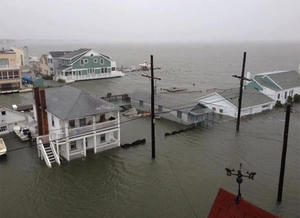Post-Sandy coastal livingPost-Sandy insurance rates increase may make coastal living unaffordable
Residents of New York and New Jersey are still coping with the destruction Hurricane Sandy caused, but home and business owners alike will soon face another burden: rising insurance rates and new building codes and requirements that could threaten many that live and work in the coastal areas of the two states

Flooding in Ocean City, NJ, brought by Hurricane Sandy // Source: paipibat.com
Residents of New York and New Jersey are still coping with the destruction Hurricane Sandy caused, but home and business owners alike will soon face another burden: rising insurance rates and new building codes and requirements that could threaten many that live and work in the coastal areas of the two states.
The New York Times reports that homeowners in the coastal areas hit by Sandy who had flood insurance, and many who did not, will now face premium increases between 20 and 25 percent per year beginning next year. These increases will help shore up the debt-ridden National Flood Insurance Program (NFIP), but at the same time these increases will add thousands of dollars to homeowners’ annual bills.
The increase in premiums, in addition to new and expensive requirements for homes being rebuilt in revamped flood hazard zones, can potentially cost more than middle-class families that live in the areas can afford. Many homeowners in those areas have hung on to their coastal abodes as they have been handed down through generations, even as development changed Queens, Staten Island, Long Island. and the Jersey Shore.
Some homeowners are not worried about the future costs, but the increase in insurance costs could lead to more upper-class families moving to the coastal areas in the northeast, even in areas that were not affected by the storm. Ronald Schiffman, who formerly worked with the New York City Planning Commission, told the Times that barring intervention by Congress or the states, there will be “a massive displacement of low income families from their historic communities.”
Since private insurers rarely provide flood coverage, the NFIP, run by the federal government, has made sure that rates are low. According to Steve Harty, president of the National Flood Services, flood insurance in high-risk areas usually costs between $1,100 and $3,000 per year. The contents of a house can be insured for up to $100,000 for about another $500 per year.
Insurance rates will begin rise at an average of 20 percent starting next year, according to the Federal Emergency Management Agency (FEMA). In the past the increases were capped at 10 percent. For buildings older than the insurance program itself, premiums previously cost half as much as newer buildings, but that provision is now being phased out.
Areas that were deemed safe fifteen or twenty years ago, and which are not in flood hazard areas, will now be treated as if they were built in those zones rather than grandfathered in. Also, it will be harder for families to drop their flood insurance if there is not a significant storm within the next few years. Insurance is required for homeowners who live in hazard areas with federally backed mortgages. Lenders who do not enforce the requirements will now face stiff penalties.
The insurance program had a deficit of $18 billion after Katrina, and was only at $3 billion when Hurricane Sandy hit the northeast. This more than anything has led to the higher premiums and new penalties. Congress was also pushed into action by environmental advocates who thought reckless development was encouraged by the program (for arguments against continuing the federal flood insurance program, see Judith Kildow and Jason Scorse, “End federal flood insurance,” New York Times, 29 November 2012).
Still some are upset by the lack of consideration when it comes to low-income housing.
“You have to move toward fiscal soundness,” J. Robert Hunter, a federal insurance administrator during the Ford and Carter administrations, told the Times. “But we’ve said you also have to add some protection for low-income people. But they’ve never done it.”
According to Hunter, less than 30 percent of homes in the affected areas had policies in effect. Dave Miller, head of the NFIP said FEMA would provide guidance on map updates of the hazard zones to local officials long before the new maps will be made official. Miller thinks that homeowners should start to think outside the box.
“It may not hit you today,” Miller told the Times, “but a year or two from now, when the maps are adopted, it’s going to hit your community, and you’re going to ask, ‘Why didn’t we hear this before?’ ”
As much as new zone maps and increasing insurance premiums will hit the wallets of homeowners, they first have to decide if they can afford to rebuild their houses at all.
